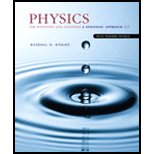
Concept explainers
a. Derive an expression for the magnetic field strength at distance d from the center of a straight wire of finite length l that carries current l.
b. Determine the field strength at the center of a current carrying square loop having sides of length
c. Compare your answer to part b to the field at the center of a circular loop of diameter
Want to see the full answer?
Check out a sample textbook solution
Chapter 29 Solutions
Physics for Scientists and Engineers: A Strategic Approach with Modern Physics (4th Edition)
- Starlord has a mass of 89.3 kg and Groot is pulling the bag with a force of 384. N at an angle of 35.0˚ as is shown in the figure below. What is the coefficient of kinetic friction if they are moving at a constant speed of 2.31 m/s?arrow_forwardEarly on in the video game Shadow of the Tomb Raider Lara Croft uses a winch to pull a heavy crate of stone up a 23.6° incline. If Lara causes the 66.0 kg crate to accelerate at 2.79 m/s2 up the ramp, what is the tension in the rope pulling the block? The coefficient of kinetic friction between the block and the ground is 0.503.arrow_forwardA player kicks a football at the start of the game. After a 4 second flight, the ball touches the ground 50 m from the kicking tee. Assume air resistance is negligible and the take-off and landing height are the same (i.e., time to peak = time to fall = ½ total flight time). (Note: For each question draw a diagram to show the vector/s. Show all the step and provide units in the answers. Provide answer to 2 decimal places unless stated otherwise.) Calculate and answer all parts. Only use equations PROVIDED:arrow_forward
- A shot putter releases a shot at 13 m/s at an angle of 42 degrees to the horizontal and from a height of 1.83 m above the ground. (Note: For each question draw a diagram to show the vector/s. Show all the step and provide units in the answers. Provide answer to 2 decimal places unless stated otherwise.) Calculate and answer all parts. Only use equations PROVIDED:arrow_forwardIf a person jumps upwards with a vertical velocity of 5 m/s, What is their velocity 0.5 second into the jump?arrow_forwardA solid sphere 22 cm in radius carries 17 μC, distributed uniformly throughout its volume. Part A Find the electric field strength 12 cm from the sphere's center. Express your answer using two significant figures. E₁ = ΜΕ ΑΣΦ ха Хь b Submit Previous Answers Request Answer <☑ × Incorrect; Try Again; 4 attempts remaining ▾ Part B ? |X| X.10" <☑ Find the electric field strength 22 cm from the sphere's center. Express your answer using two significant figures. ΜΕ ΑΣΦ E2 = Submit Request Answer ▾ Part C ? MN/C Find the electric field strength 44 cm from the sphere's center. Express your answer using two significant figures. ΕΠΙ ΑΣΦ E3 = Submit Request Answer ? MN/C MN/Carrow_forward
- No chatgpt plsarrow_forwardIn a naval battle, a battleship is attempting to fire on a destroyer. The battleship is a distance d1 = 2,150 m to the east of the peak of a mountain on an island, as shown in the figure below. The destroyer is attempting to evade cannon shells fired from the battleship by hiding on the west side of the island. The initial speed of the shells that the battleship fires is vi = 245 m/s. The peak of the mountain is h = 1,840 m above sea level, and the western shore of the island is a horizontal distance d2 = 250 m from the peak. What are the distances (in m), as measured from the western shore of the island, at which the destroyer will be safe from fire from the battleship? (Note the figure is not to scale. You may assume that the height and width of the destroyer are small compared to d1 and h.)arrow_forwardNo chatgpt plsarrow_forward
- The law of reflection applies to Question 14Select one: a. specular reflection b. irregular reflection c. All of these d. diffuse reflectionarrow_forwardAccording to your book "normal" human body temperature is considered to be ________? Select one: a. none of these b. 98.6°C c. 37°C d. 100°Carrow_forwardProblem Seven. A football receiver running straight downfield at 5.60 m/s is 11.5 m in front of the quarterback when a pass is thrown downfield at an angle of 35.0° above the horizon. 8.) If the receiver never changes speed and the ball is caught at the same height from which it was thrown, find the distance between the quarterback and the receiver when the catch is made. (A) 21.3 (B) 17.8 (C) 18.8 (D) 19.9 (E) 67.5arrow_forward

 College PhysicsPhysicsISBN:9781305952300Author:Raymond A. Serway, Chris VuillePublisher:Cengage Learning
College PhysicsPhysicsISBN:9781305952300Author:Raymond A. Serway, Chris VuillePublisher:Cengage Learning College PhysicsPhysicsISBN:9781285737027Author:Raymond A. Serway, Chris VuillePublisher:Cengage Learning
College PhysicsPhysicsISBN:9781285737027Author:Raymond A. Serway, Chris VuillePublisher:Cengage Learning Physics for Scientists and Engineers: Foundations...PhysicsISBN:9781133939146Author:Katz, Debora M.Publisher:Cengage Learning
Physics for Scientists and Engineers: Foundations...PhysicsISBN:9781133939146Author:Katz, Debora M.Publisher:Cengage Learning Principles of Physics: A Calculus-Based TextPhysicsISBN:9781133104261Author:Raymond A. Serway, John W. JewettPublisher:Cengage Learning
Principles of Physics: A Calculus-Based TextPhysicsISBN:9781133104261Author:Raymond A. Serway, John W. JewettPublisher:Cengage Learning Glencoe Physics: Principles and Problems, Student...PhysicsISBN:9780078807213Author:Paul W. ZitzewitzPublisher:Glencoe/McGraw-Hill
Glencoe Physics: Principles and Problems, Student...PhysicsISBN:9780078807213Author:Paul W. ZitzewitzPublisher:Glencoe/McGraw-Hill





